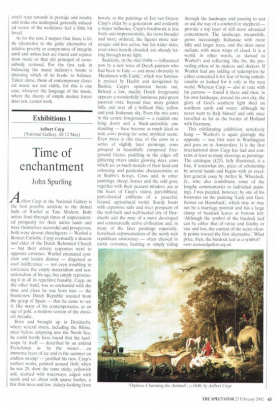Aelbert Cuyp (National Gallery, till 12 May)
Time of enchantment
John Spurhng
Aelbert Cuyp at the National Gallery is the best possible antidote to the dismal halls of Warhol at Tate Modern. Both artists lived through times of unprecedented prosperity for their native lands and were themselves successful and prosperous, both were devout churchgoers ŌĆö Warhol a Roman Catholic, Cuyp eventually a deacon and elder of the Dutch Reformed Church ŌĆö but their artistic responses went to opposite extremes. Warhol emanated cynicism and leaden dismay ŌĆö disguised as cool indifference ŌĆö not even troubling to caricature the empty materialism and sensationalism of his age, but simply reproducing it in all its repetitive banality. Cuyp, on the other hand, was so enchanted with the time and place he was born into ŌĆö the brand-new Dutch Republic wrested from the grasp of Spain ŌĆö that he came to see it, like many of his contemporaries, as an age of gold, a modern version of the classical Arcadia.
Born and brought up in Dordrecht, where several rivers, including the Rhine, meet before emptying into the North Sea, he could hardly have found that the landscape by itself ŌĆö described by an unkind Frenchman as 'in the winter. ... an immense layer of ice and in the summer an endless swamp' ŌĆö justified his view, Cuyp's earliest works, painted around 1640, when he was 20, show the same sticky, yellowish soil, seamed with waterways, edged with reeds and set about with sparse bushes, a few thin trees and low, rickety-looking farm hovels, as the paintings of Jan van Goyen. Cuyp's elder by a generation and evidently a major influence. Cuyp's brushwork is less lively and impressionistic, his views broader and more ordered, the figures more statuesque and less active, but his wider skies, even when heavily clouded, are already letting through more light.
Suddenly, in the mid-1640s ŌĆö influenced now by a new wave of Dutch painters who had been to Italy ŌĆö and most obviously in 'Herdsmen with Cattle', which was famously praised by Hazlitt and denigrated by Ruskin, Cuyp's optimism bursts out. Behind a low, muddy Dutch foreground appears a wonderfully luminous pale-green pastoral vista, beyond that, misty golden hills, and over all a brilliant blue, yellow and pink Italianate sky. Even the two cows in the centre foreground ŌĆö a reddish one lying down and a black-and-white one standing ŌĆö have become as much ideal as real, cows posing for some mythical scene. Even more is this true of the cows in a series of slightly later paintings, cows grouped in beautifully composed foreground friezes, paddling in the edges off glittering rivers under glowing skies, cows which are as much models of their kind and colouring and particular characteristics as in Stubbs's horses. Cows and, in other paintings. sheep, horses and the odd goat, together with their peasant minders, are at the heart of Cuyp's vision, part-biblical, part-classical emblems of a peaceful, fecund, agricultural world. Sturdy boats with expansive sails and river prospects of the well-built and well-heeled city of Dordrecht add the note of a more developed and commercially active civilisation and, in many of the later paintings especially, horseback representatives of the newly rich republican aristocracy ŌĆö often dressed in exotic costumes, hunting or simply riding through the landscape and pausing to rest or ask the way of a cowherd or shepherd ŌĆö provide a top layer of still more advanced contentment. The landscape, meanwhile, grows increasingly Italianate with more hills and larger trees, and the skies more radiant, with mere wisps of cloud. It is a world, in other words, as skewed as Warhol's and reflecting, like his, the prevailing ethos of its makers and shakers, If Warhol had any inkling of redemption he either concealed it for fear of being unfashionable or looked for it only in the next world. Whereas Cuyp ŌĆö also in tune with his patrons ŌĆö found it there and then, in his own landscape, around his own city, the glory of God's southern light shed on northern earth and water, although he never went to Italy himself and only once travelled as far as the border of Holland with Germany.
This exhilarating exhibition, sensitively hung ŌĆö Warhol's is again glaringly the opposite ŌĆö was first seen in Washington and goes on to Amsterdam. It is the first international show Cuyp has had and contains at least as many drawings as paintings. The catalogue (┬Ż25), fully illustrated, is a fine, if somewhat dry, piece of scholarship by several hands and begins with an excellent general essay by Arthur K. Wheelock. Jr., who also contributes some of the lengthy commentaries to individual paintings. I was puzzled, however, by one of his footnotes on the painting 'Lady and Gentleman on Horseback', which may or may not be a marriage portrait and has a large clump of burdock leaves at bottom left: 'Although the symbol of the burdock leaf can be either that of virtue and fidelity or vice and lust, the context of the scene clearly points toward the first alternative.' What price, then, the burdock leaf as a symbol? WWW. nationalgalloy.org.uk






































































 Previous page
Previous page